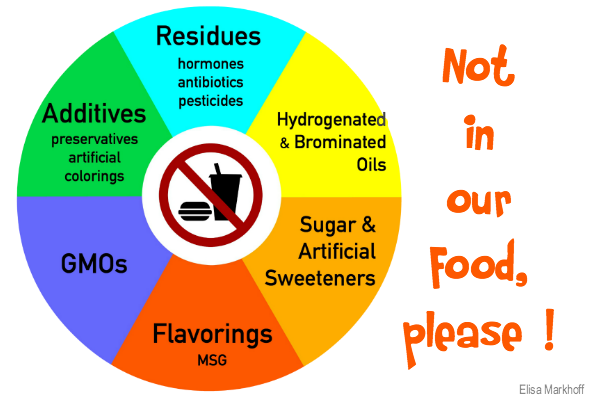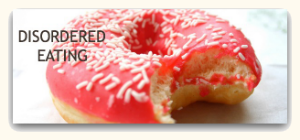Parents are faced with a myriad of food choices on a daily basis (as if raising kids wasn’t hard enough!). We all want the best for our children: nutritious food that is flavorful and nourishing, enjoyable and healthy. But each family has different health challenges and needs, diverse backgrounds, habits and traditions.
So how do we start cleaning up our plates without feeling guilty or breaking the bank? A good place to begin is to become educated about our choices.
There are several food ingredients that have no place in a healthy diet, and that have already been banned in other countries. In the US, many school districts are removing them as well due to their negative health effects.
In order to help you identify the worst offenders, we have created this short list of the Big Six Groups with a total of nine main ingredients that you should be weary of, where they are found, why they are unhealthy, and how to best avoid them.

1. Additives
Coloring Agents Blue 1 E133, Blue 2 E132, Citrus Red 2, Red 3 E127, Red 40 E129, Yellow 5 (Tartrazine) E102, and Yellow 6 E110
Found in: Cake, candy, macaroni and cheese, medicines, sport drinks, soda and cheese
Why it’s still being used: We eat with our eyes. This may explain why the use of artificial dyes have increased five-fold since 1955.
Health hazards: Back in the day, food coloring came from natural sources, such as saffron and turmeric. Today most artificial colors are made from coal tar, which is also used to seal-coat products to preserve and protect the shine of industrial floors.
Research has associated food dyes with allergies, hyperactivity, learning impairment, irritability, and aggressiveness.
Avoid them: check the ingredients list and label of products.
Most of these are banned and/or restricted for ingestion in Europe
2. Preservatives
Ingredient: Butylated Hydroxyanisole E320 (BHA) and Butylated Hydroxytoluene E321 (BHT); calcium propionate, sodium acid pyrophosphate, sodium nitrate, disodium dihydrogen pyrophosphate, and calcium pyrophosphate.
Found in: baked goods, snack foods, frozen entrées, processed meats like sausages and lunch meats.
Why it’s still being used: preservatives are compounds that prevent food from breaking down as part of the normal process of decay or digestion. Hence, they prolong the shelf life of many products.
Health hazards: Nitrates, nitrites, and other artificial preservatives increase risk of certain cancers by up to 50 percent. BHA and BHT are manufactured from petroleum (yummy!). Most of these preservatives are banned in Europe and Japan.
If this weren’t enough, children who eat a lot of foods containing preservatives may not be able to properly digest whatever nutrients are contained in those foods, because the preservatives are doing their job – preventing proper digestion.
Avoid them: Check the labels, especially those of processed meats like lunchmeats and sausages, for BHA, BHT, benzoates, sulfates, and sorbates, among others.
3. Hormones
Ingredients: Synthetic hormones (rBGH and rBST)
Found in: Milk and dairy products.
Why it’s still being used: to improve production. Dairy farmers inject cows with genetically engineered cow growth hormones to boost milk production by about 10 percent.
Health hazards: Cows treated with these synthetic hormones often become lame, infertile, and suffer from inflamed and infected udders. And humans, who consume these cows’ byproducts, have high levels of IGF-1 (insulin growth factor -1), which has been linked to breast, colon, and prostate cancers.
Avoid it: if you consume animal products, buy dairy products free of synthetic hormones and antibiotics. Grass fed, organic and non-homogenized are your best choices.
Growth hormones are banned in Europe
Also notice that while the US does not permit the injection of hormones in hogs, chickens or turkeys, these animals can be fed chemical growth enhancers.
4. Antibiotics
Found in: meats and dairy products.
Why they’re still being used: Antibiotics are used in the production of industrially farmed beef and other livestock to boost production and prevent bacterial infections. This industry consumes over 70% of all antibiotics used in the US.
Health hazards: The problem with feeding antibiotics to animals that are not sick is that it kills off weak bacteria and creates the perfect environment for antibiotic-resistant bacteria to multiply and thrive. Once these drug-resistant bacteria develop, they can spread far and wide and cause infections that are hard to treat.
Avoid it: if your family consumes animal products, buy meat and dairy free of antibiotics. Grass fed and organic are your best choices.
5. Sugar substitutes
Ingredients: high fructose corn syrup (HFCS), aspartame (NutraSweet), sucralose (Splenda)
Found in: these are extremely widespread and are “hidden” not only sweet foods and beverages but also sauces, dressings, crackers… always check labels.
Why they’re still being used: since there’s been a dietary guideline to reduce fats, many companies are replacing fats with sugar to enhance food flavor.
Health hazards: sugar itself has been linked to a myriad of diseases and conditions, from hyperactivity to inflammation and diabetes. However, research suggests that sugar substitutes in particular have serious short- and long-term risks, and are worse than the real thing.
For example, aspartame contains small amounts of methanol, a toxic alcohol, and it may disrupt brain chemistry, possibly increasing the risk of seizures, depression, and headaches.
High fructose corn syrup contains dangerous chemicals and contaminants, and it’s one of the lead causes of fatty liver, the most common disease in America today affecting 90 million people. HFCS has been banned in Europe
Avoid them: there are over 50 different names for sweeteners, but if you check labels for aspartame, sucralose and anything involving corn syrup you are off to a good start.
6. Flavorings
Ingredients: Mono Sodium Glutamate (MSG)
Found in: almost all processed and packaged foods
Why they’re still being used: MSG stimulates taste buds, making bland food more appetizing – thus making you want to eat more… and buy more food.
Health hazards: most common side effects are changes in blood pressure, joint pain, diarrhea, irregular heartbeat, anxiety, migraines and seizures, and even brain damage.
MSG use is restricted by legislation in Europe
Avoid it: tricky, since it may be masquerading in a label under over 30 aliases, for example: glutamic acid, glutamate, sodium caseinate, hydrolyzed corn, yeast food, carrageenan, soy sauce, natural flavors. Your best bet to avoid it is to buy organic foods.
7. Brominated products
Ingredient: Brominated vegetable oil (aka BVO), potassium bromate
Found in: Sports drinks and citrus-flavored sodas; baked goods
Why it’s still being used: BVO prevents the flavoring from separating and floating to the surface of beverages. Bromate is an emulsifier.
Health hazards: Because BVOs competes with iodine for receptor sites in the body, elevated levels may lead to thyroid issues, such as hypothyroidism, autoimmune disease, and cancer. Besides, BVO’s main ingredient, bromine, is a poisonous chemical that has been linked to major organ system damage, birth defects, growth problems, schizophrenia, and hearing loss, which explains why it’s been banned in more than 100 countries
Avoid it: scan labels for BVO, brominated oil, and potassium bromate.
8. Hydrogenated oils
Found in: crackers, cookies, cakes, doughnuts, frozen dinners, French fries, shortenings and margarines, Girl Scout cookies (yes!)
Why they’re still being used: when vegetable oil and hydrogen are combined through a process called hydrogenation, it creates a product with greater stability that is less likely to spoil.
Health hazard: hydrogenated oils are trans fats, which contribute to clogged arteries and significantly increase the risk of heart attack and stroke.
Avoid it: it’s not easy, because many foods that claim to have “0 trans fats” have less than 0.5 g of trans fats per serving – a labeling loophole (this is the case of Girl Scout cookies, for example). Always check the label: anything that says “partially hydrogenated oil”, “hydrogenated oil” or “shortening” contains trans fats, no matter what the packaging claims.
Trans fats are banned in Europe and will be banned in the US over a period of three years
9. GMOs
Ingredients: genetically altered organisms.
Found in: corn, canola, soybeans (edamame), papaya, yellow summer squash, zucchini and sugar beets are the most popular GMO crops
Why the U.S. allows it: to increase crop yield and pest resistance, boost production and improve flavor
Health hazards: environmental issues aside, long-term consequences of GMO use remain largely unknown. The few independent animal studies done using GMOs don’t look promising – effects include infertility, immune problems, accelerated aging, faulty insulin regulation, and changes in major organs and the gastrointestinal system. Many countries have decided to err on the side of caution and ban their use.
Avoid them: to this date, GMOs are not labeled in the US. Your best bet is to buy organic or look for a seal of approval (Non-GMO Project Verified Seal). Also, make sure your meat is grass fed since only since most livestock are fed GMO cornmeal.
Please remember! It’s normal to feel overwhelmed when trying to make dietary adjustments. Give yourself time to become familiar with these names and start playing detective at your local supermarket – there are plenty of healthy choices at Costco, Giant, Weiss, Trader Joe’s, Wegmans, Whole Foods and Target. Don’t be discouraged! Your family will thank you for your efforts.









